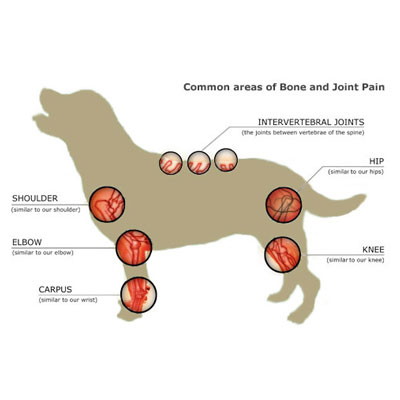Also known as degenerative joint disease mostly affects older dogs. In a healthy dog, a coating of cartilage protects the connecting surfaces of a joint. This allows the bones to move smoothly over one another reducing friction. When osteoarthritis is present the cartilage around the joint is often damaged. This creates friction as bones make contact with each other, leading to inflammation and further soft tissue damage.
The constant rubbing of the bones can cause bony spurs to develop around the affected bone surfaces causing further pain, inflammation and reduced mobility. Reduced mobility can lead to loss of strength in supporting muscles and ligaments becoming slack. Reduced mobility can also cause dogs to put weight on increasing the stress placed on the joints, including elbows, hips, Stifle (knee joint), shoulders, Carpus (wrist), Hock (ankle) and intervertebral joints (backbone).
Warning Signs of Arthritis in Dogs
Dogs suffering from osteoarthritis can experience discomfort and pain that result from damage within the above-mentioned joint. The below mentioned 10 signs can be symptoms of canine arthritis. Make sure to check with your vet if your canine companion is displaying any of these symptoms:
- Reluctance to climb stairs or difficulty jumping up
- Difficulty or hesitation to get up or sit down
- Stiffness in the morning that improves as the day progresses
- Lameness in one or more limbs
- Subtle signs that the pet may not want to put weight on the limb
- Sensitivity when touched in certain areas
- Abnormal behaviours in dog such as withdrawal, irritability or aggression
- Licking or chewing at the painful joint
- Reluctance to rise or difficulty rising
- Pain when handled
Massage can help…
Massage has been shown to help improve this condition. The increased lymphatic function generated during a massage improves the transfer of nutrients to, and removal of toxins from, the joints. This reduces inflammation and its associated pain. Massage can also help osteoarthritis by:
- Increasing circulation
- Increasing flexibility
- Decreasing inflammation
- Lowering pain
- Lessening joint stiffness
- Improving muscle aches


